Disaster Management System Aided by Named Data Network of Things: Architecture, Design, and Analysis
Abstract
1. Introduction
- We introduce the NDN architecture in an IoT based DMS and highlight its effectiveness in terms of scalability and content based communication infrastructure.
- We simulate IoT based SC with distinct nodes (i.e., both stationary and mobile) distribution in different clusters.
- We evaluate and compare our proposed scheme NDN-DISCA against relevant schemes from [23] through analytical and quantitative analysis in terms of average delay (AD) and average throughput (ATH) and finds NDN-DISCA more feasible for IoT-DMS-SC.
2. Related Research Efforts
3. Naive NDN Architecture
4. Proposed NDN Based DMS for IoT Based Smart Campus Use Case
4.1. Overview of Proposed Scheme
4.2. Processing of Consumer and Producer in Normal Mode
4.3. Processing of Consumer and Producer in Disaster Mode
4.3.1. Processing of Producer in Disaster Mode
| Algorithm 1 Proposed NDN Module for Producer . |
| Input: FS, TL, HC Output: BAM sent by the Producer
|
4.3.2. Processing of Consumer in Disaster Mode
| Algorithm 2 Proposed NDN Module for Consumer c |
| Input: BAM, HC Output: BAM to all Nearby Consumers
|
4.4. Performance Metrics
4.4.1. Average Delay (AD)
4.4.2. Average Throughput (ATH)
4.4.3. Percentage Throughput Gain (% THG)
5. Simulation Scenarios
5.1. Scenario: 1 Disaster Occur in Smart Lab 1 (SL-1)
5.2. Scenario: 2 Disaster Occur in Smart Lab 2 (SL-2)
6. Experimental Setup
7. Performance Analysis
7.1. Average Delay (AD)
7.2. Average Throughput (ATH)
7.3. Percentage Throughput Gain (% THG)
8. Conclusions and Future Work
Author Contributions
Funding
Acknowledgments
Conflicts of Interest
References
- Gubbi, J.; Buyya, R.; Marusic, S.; Palaniswami, M. Internet of Things (IoT): A vision, architectural elements, and future directions. FGCS 2013, 29, 1645–1660. [Google Scholar] [CrossRef]
- Evans, D. The Internet of Things How the Next Evolution of the Internet Is Changing Everything; CISCO: San Jose, CA, USA, 2011. [Google Scholar]
- Saxena, D.; Raychoudhury, V. Design and Verification of an NDN-Based Safety-Critical Application: A Case Study With Smart Healthcare. IEEE Trans. Syst. Man Cybern. B Cybern. 2017. [Google Scholar] [CrossRef]
- Ahmed, S.H.; Kim, D. Named data networking-based smart home. KICS 2016, 2, 130–134. [Google Scholar] [CrossRef]
- Marica, A.; Campolo, C. Information Centric Networking in IoT scenarios: The case of a smart home. In Proceedings of the Communications (ICC), London, UK, 8–10 June 2015. [Google Scholar]
- Arshad, S.; Shahzaad, B.; Azam, M.A. Hierarchical and Flat based Hybrid Naming Scheme in Content-Centric Networks of Things. IEEE Internet Things J. 2017, 5, 1070–1080. [Google Scholar] [CrossRef]
- Arshad, S.; Azam, M.A.; Ahmed, S.H. Towards Information-Centric Networking (ICN) Naming for Internet of Things (IoT): The Case of Smart Campus. In Proceedings of the ICFNDS, Cambridge, UK, 19–20 July 2017. [Google Scholar]
- Alghamdi, A.; Shetty, S. Survey: Toward A Smart Campus Using the Internet of Things. In Proceedings of the International Conference on Future Internet of Things and Cloud, Vienna, Austria, 22–24 August 2016. [Google Scholar]
- Shang, W.; Ding, Q.; Marianantoni, A.; Burke, J.; Zhang, L. Securing Building Management Systems Using Named Data Networking. IEEE Netw. 2014, 28. [Google Scholar] [CrossRef]
- Piro, G.; Cianci, I.; Grieco, L.A.; Boggia, G.; Camarda, P. Information Centric Services in Smart Cities. J. Syst. Softw. 2013, 88, 169–188. [Google Scholar] [CrossRef]
- SONSINI, W.; ROSATI, G. Zizmos. Available online: http://www.zizmos.com/news?page=3 (accessed on 10 August 2016).
- Holcomb, J.E. IoT. Available online: http://www.in.gov/iot/2336.html (accessed on 10 August 2016).
- KKRAMER, K. Fire at University of St Andrews Chemistry Department. Available online: http://www.chemistryworld.com/news/fire-at-university-of-st-andrews-chemistry-department-/3007689.article (accessed on 12 June 2017).
- Tube, U. University of Lahore Fire. Available online: http://www.youtube.com/watch?v=toZbEMUcdnU (accessed on 3 May 2016).
- Majeed, M.F.; Ahmed, S.H.; Muhammad, S.; Song, H.; Rawat, D.B. Multimedia streaming in information-centric networking: A survey and future perspectives. Comput. Netw. 2017, 32, 103–121. [Google Scholar] [CrossRef]
- Amadeo, M.; Campolo, C.; Quevedo, J.; Corujo, D.; Molinaro, A.; Iera, A.; Aguiar, R.L.; Vasilakos, A.V. Information-Centric Networking for the Internet of Things. IEEE Netw. Mag. 2016, 30. [Google Scholar] [CrossRef]
- Kim, S.Y.; Robitzsch, S.; Reed, M.; Riihijarvi, J. Realizing IP-based Services over an Information-Centric Networking Transport Network. In Proceedings of the Internetional Conference on Networking, Kyoto, Japan, 26–28 September 2016. [Google Scholar]
- Rayes, A.; Morrow, M.; Lake, D. Internet of Things Implications on ICN. In Proceedings of the Collaboration Technologies and Systems (CTS), Denver, CO, USA, 21–25 May 2012. [Google Scholar]
- Baccelli, E.; Mehlis, C.; Hahm, O.; Schmidt, T.C. Information centric networking in the IoT: Experiments with NDN in the wild. In Proceedings of the International Conference on Networking, Paris, France, 24–26 September 2014. [Google Scholar]
- Ahlgren, B.; Dannewitz, C.; Imbrenda, C.; Kutscher, D.; Ohlman, B. A survey of information-centric networking. IEEE Commun. Mag. 2012, 50. [Google Scholar] [CrossRef]
- Akbar, M.S.; Khaliq, K.A. Information-centric networks: Categorizations, challenges, and classifications. In Proceedings of the Wireless and Optical Communication Conference (WOCC), Newark, NJ, USA, 9–10 May 2014. [Google Scholar]
- Xylomenos, G.; Ververidis, C.N.; Siris, V.A.; Fotiou, N.; Tsilopoulos, C.; Vasilakos, X.; Katsaros, K.V.; Polyzos, G.C. A survey of information-centric networking research. IEEE Commun. Surv. Tutor. 2014, 16, 1024–1049. [Google Scholar] [CrossRef]
- Marica, A.; Campolo, C.; Antonella, M. Internet of Things via Named Data Networking: The Support of Push Traffic. In Proceedings of the International Conference and Workshop on the Network of the Future (NOF), Paris, France, 3–5 December 2014. [Google Scholar]
- Majeed, M.F.; Ahmed, S.H.; Muhammad, S.; Song, H.; Rawat, D.B. Multimedia streaming in information-centric networking: A survey and future perspectives. J. Netw. Comput. Appl. 2017, 125, 103–121. [Google Scholar] [CrossRef]
- Dynerowicz, S.; Mendez, P. Named-Data Networking in Opportunistic Networks. In Proceedings of the International Conference Networks, Berlin, Germany, 26–28 September 2017. [Google Scholar]
- Majeed, M.F.; Ahmed, S.H.; Dailey, M.N. Enabling Push-Based Critical Data Forwarding in Vehicular Named Data Networks. IEEE Commun. Lett. 2016, 21, 873–876. [Google Scholar] [CrossRef]
- Yaqub, M.A.; Ahmed, S.H. Interest forwarding in vehicular information centric networks: A survey. In Proceedings of the Annual ACM Symposium on Applied Computing, SAC, Pisa, Itlay, 4–8 April 2016. [Google Scholar]
- Seedorf, J.; Stuttgart, H.; Kutscher, D.; Gill, S.B. Decentralised Interest Counter Aggregation for ICN in Disaster Scenarios. In Proceedings of the 2016 IEEE Globecom Workshops (GC Wkshps), Washington, DC, USA, 4–8 December 2016. [Google Scholar]
- YAO, H. A Scheme of Ad-hoc-Based D2D Communication in Cellular Networks. AdHoc Sens. Wirel. Netw. 2016, 32, 115–130. [Google Scholar]
- Cerf, V.; Burleigh, S. Delay-Tolerant Networking Architecture; Internet Engineering Task Force (IETF): Fremont, CA, USA, 2015. [Google Scholar]
- Arumaithurai, M.; Seedorf, J. Using Icn in Disaster Scenarios; Internet Engineering Task Force (IETF): Fremont, CA, USA, 2015. [Google Scholar]
- Psaras, I.; Saino, L. Name-based replication priorities in disaster cases. In Proceedings of the Computer Communications Workshops Infocom Wkships, Toronto, ON, Canada, 27 April–2 May 2014. [Google Scholar]
- Vasilis, S.; Tassiulas, L.; Psaras, I. Information resilience through user-assisted caching in disruptive content-centric networks. In Proceedings of the IFIP Networking Conference, Toulouse, France, 20–22 May 2015. [Google Scholar]
- Toru, H.; Tara, Y. Poster: Emergency Message Delivery Mechanism in NDN Networks. In Proceedings of the International Conference Networking, Kyoto, Japan, 26–28 September 2016. [Google Scholar]
- Chen, J.; Arumaithurai, M.; Jiao, L.; Fu, X.; Ramakrishnan, K. Copss: An efficient content oriented publish/subscribe system. In Proceedings of theIEEE/ACM Symposium on ANCS, Brooklyn, NY, USA, 3–4 October 2011. [Google Scholar]
- Zheng, Y. Emergency Message Delivery. Available online: http://github.com/gustybear/ (accessed on 3 November 2014).
- Marica, A.; Campolo, C. Named Data Networking for IoT: An Architectural Perspective. In Proceedings of the Networks and Communications (EuCNC), Bologna, Itlay, 23–26 June 2014. [Google Scholar]
- Saxena, D.; Raychoudhury, V. Named Data Networking: A survey. Comput. Sci. Rev. 2016, 19, 15–55. [Google Scholar] [CrossRef]
- Mastorakis, S. ndnSIM 2.0: A New Version of the NDN Simulator for NS-3; University of California (UCLA): Los Angeles, CA, USA, 2015. [Google Scholar]
- Ahmed, N. A comparison of 802.11ah and 802.15.4 for IoT. KICIS 2016, 2, 100–102. [Google Scholar] [CrossRef]
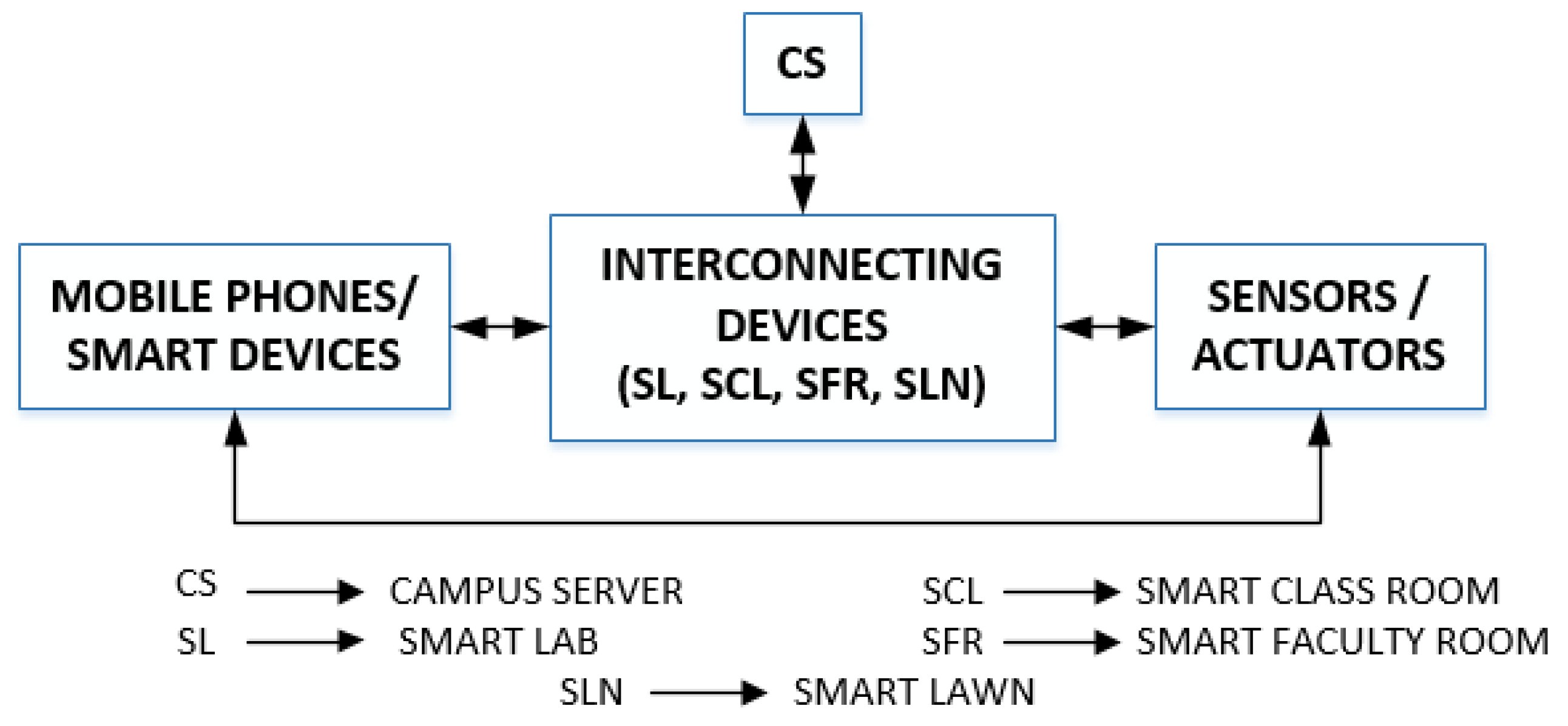
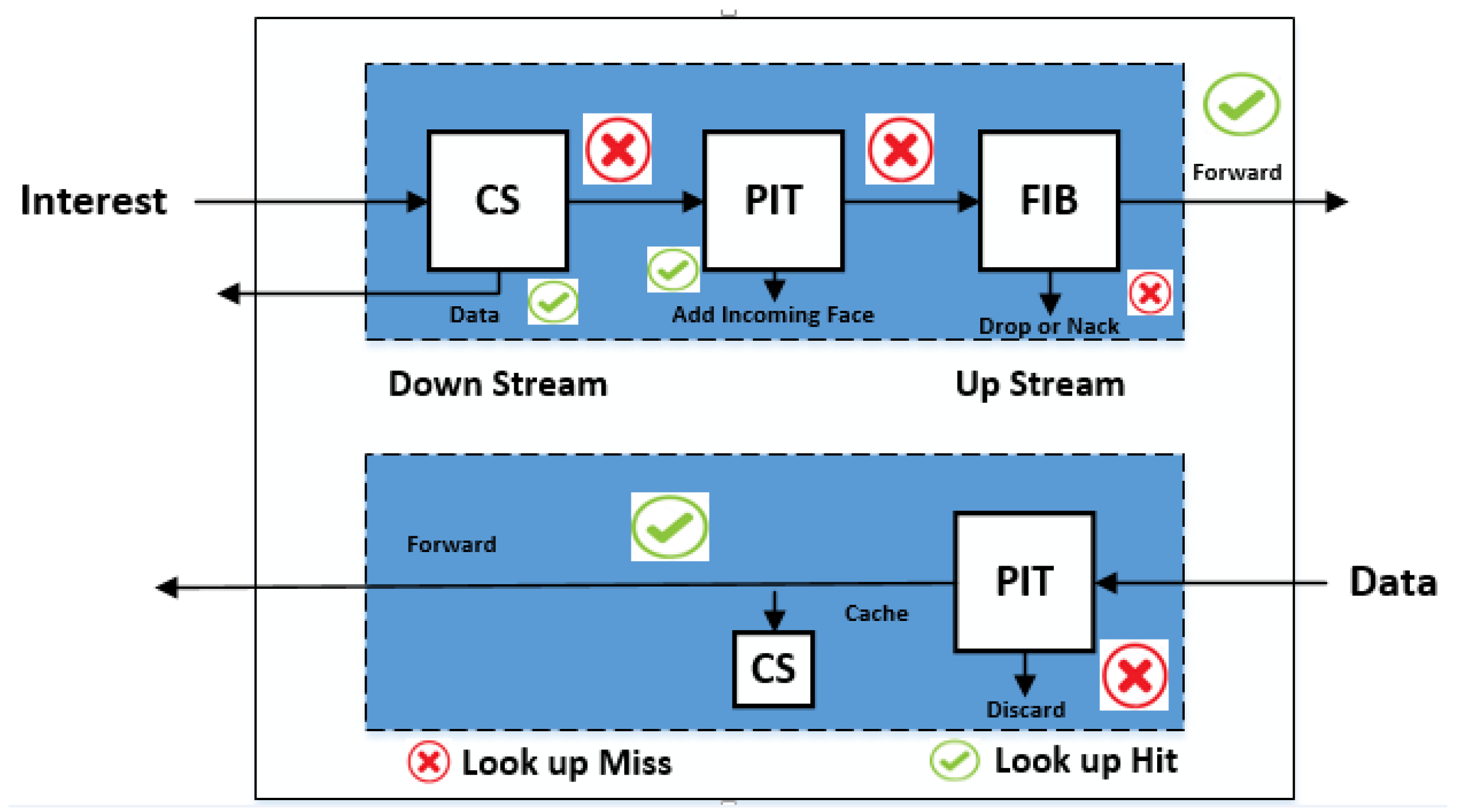
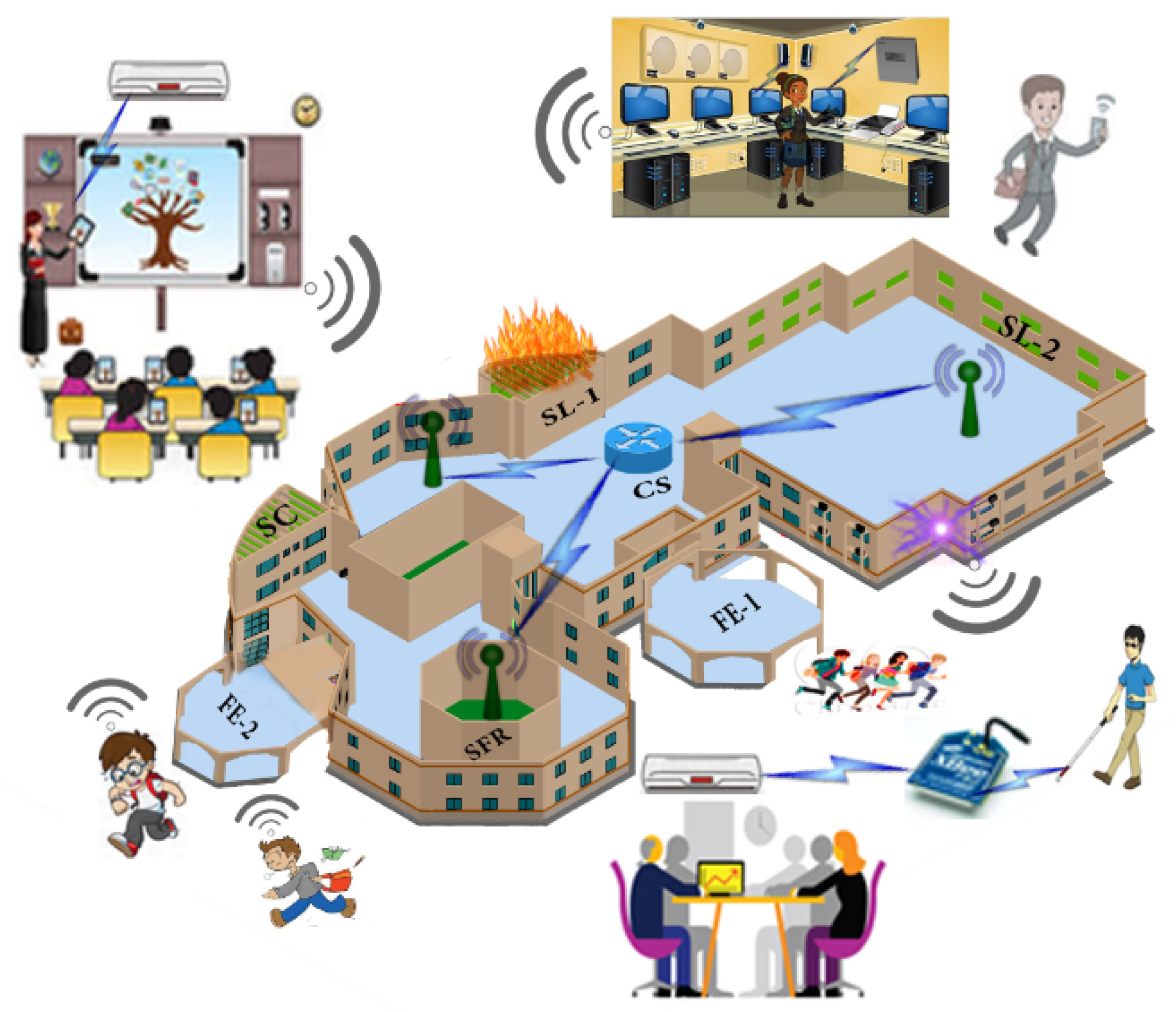
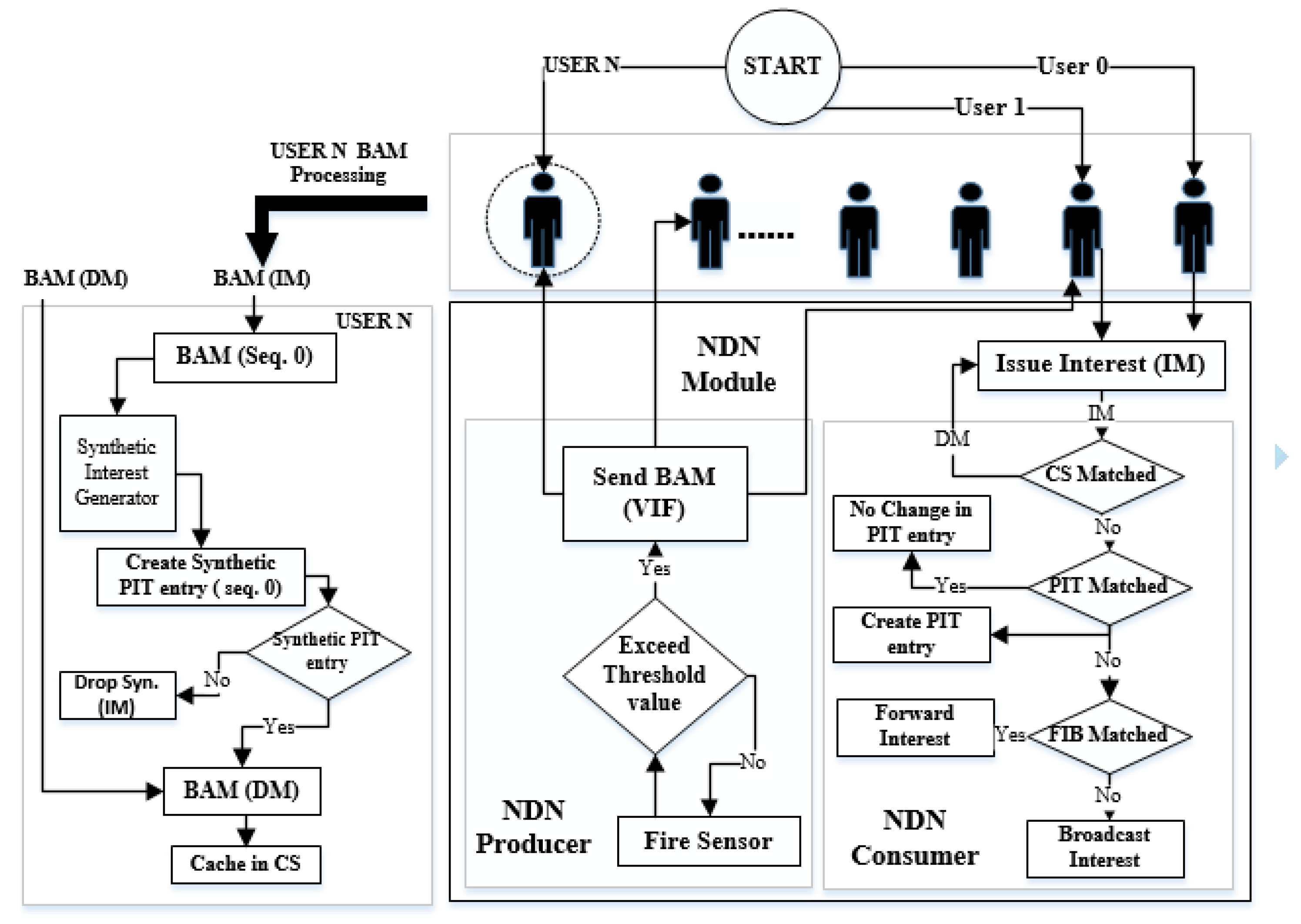
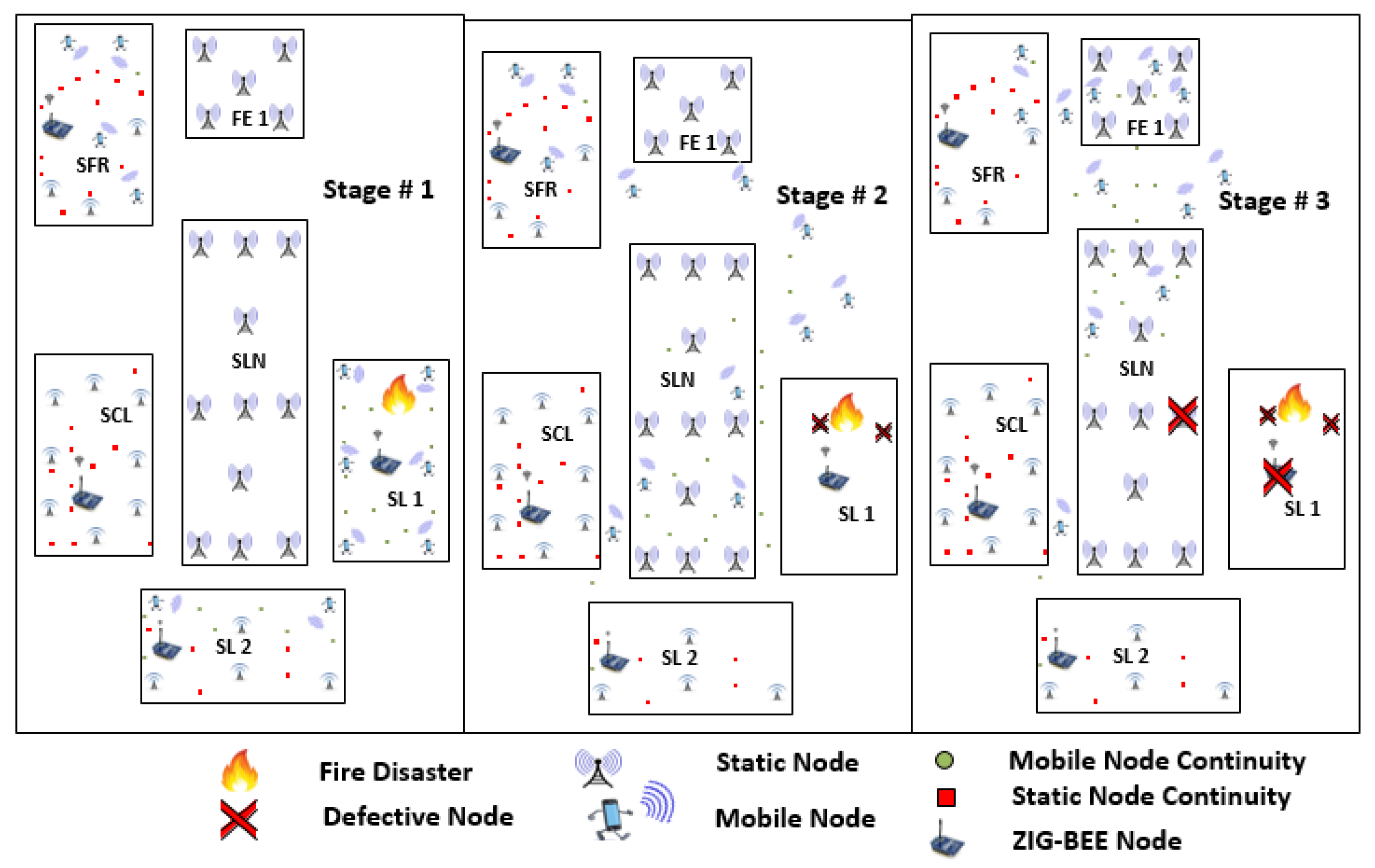
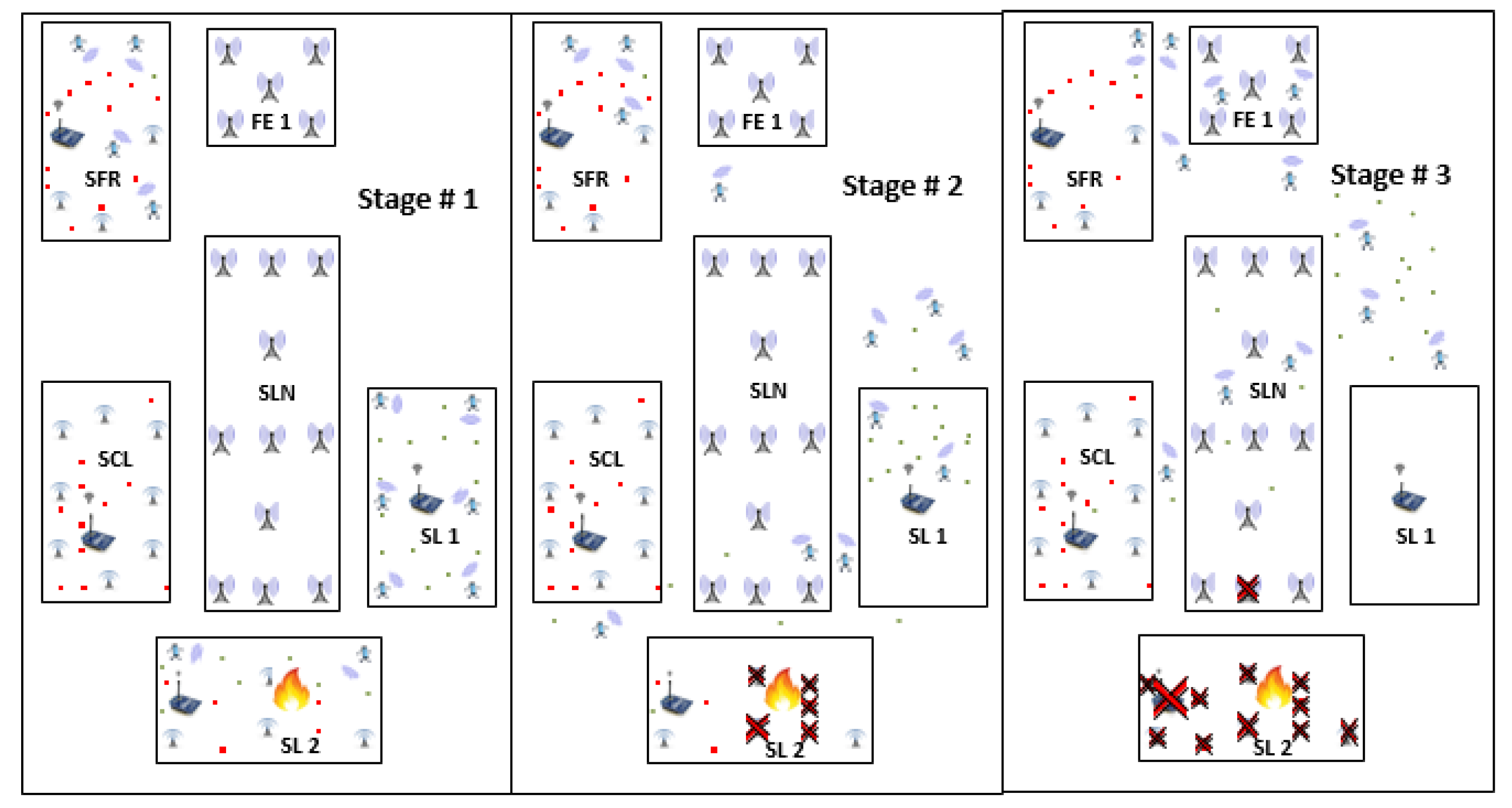


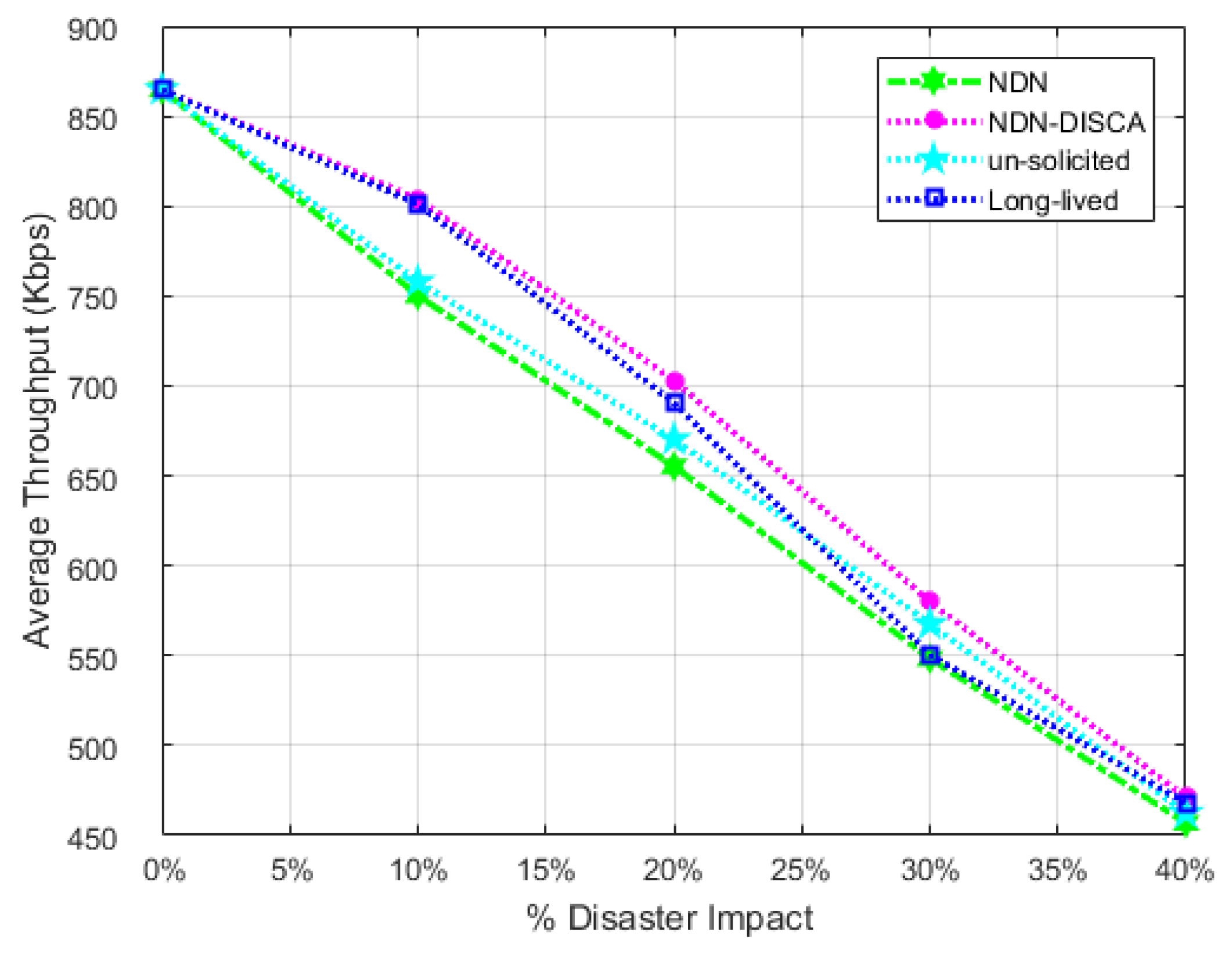
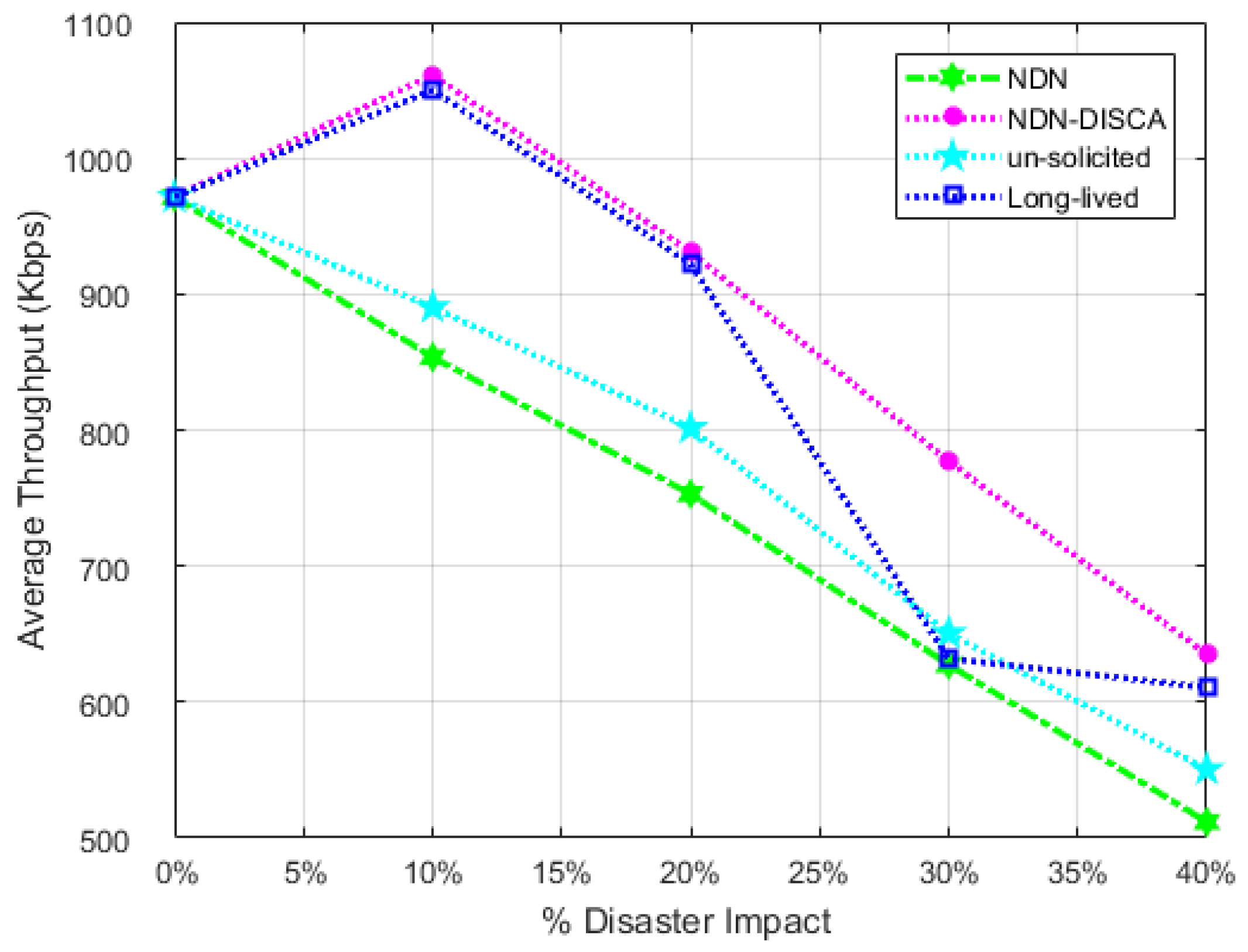
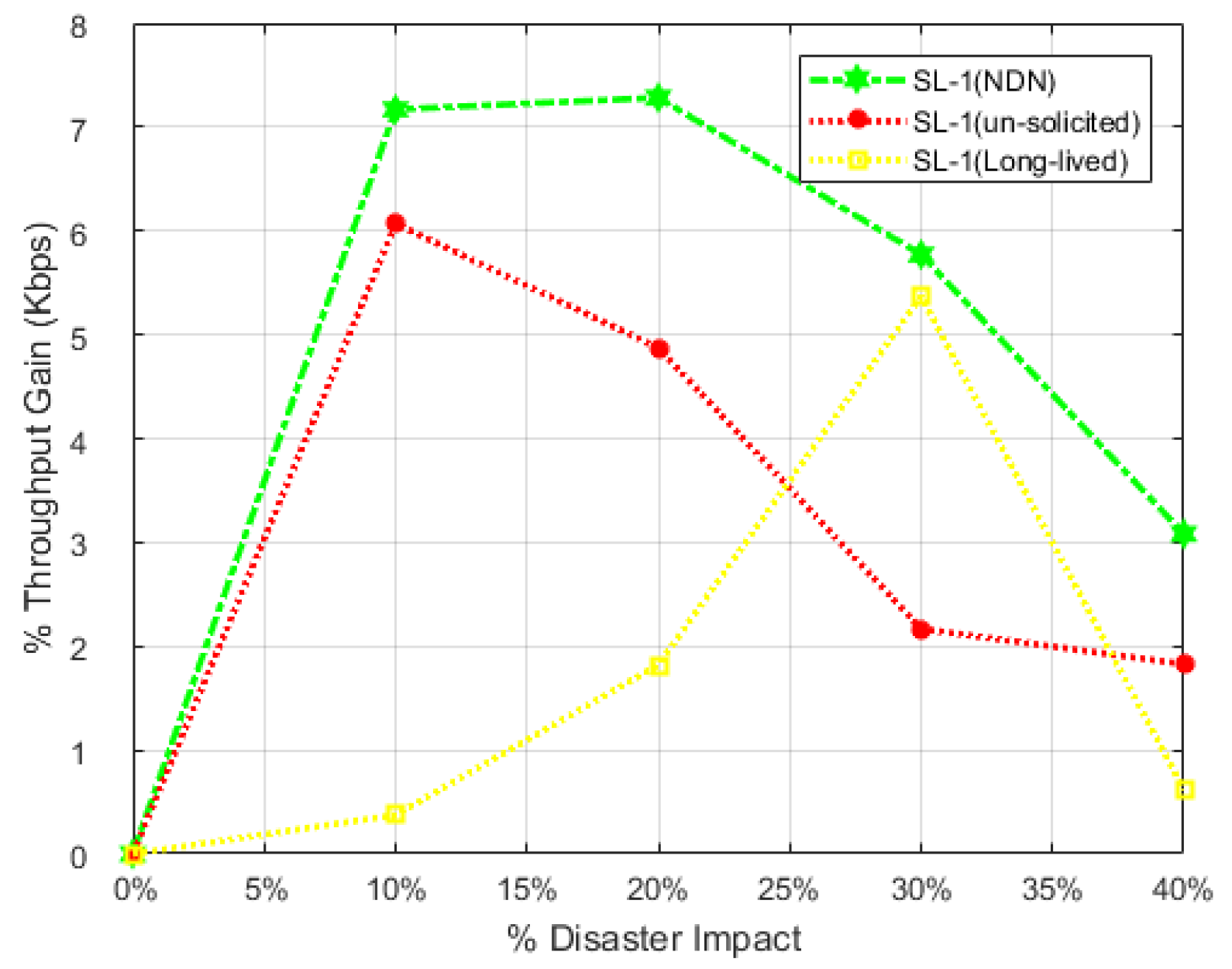
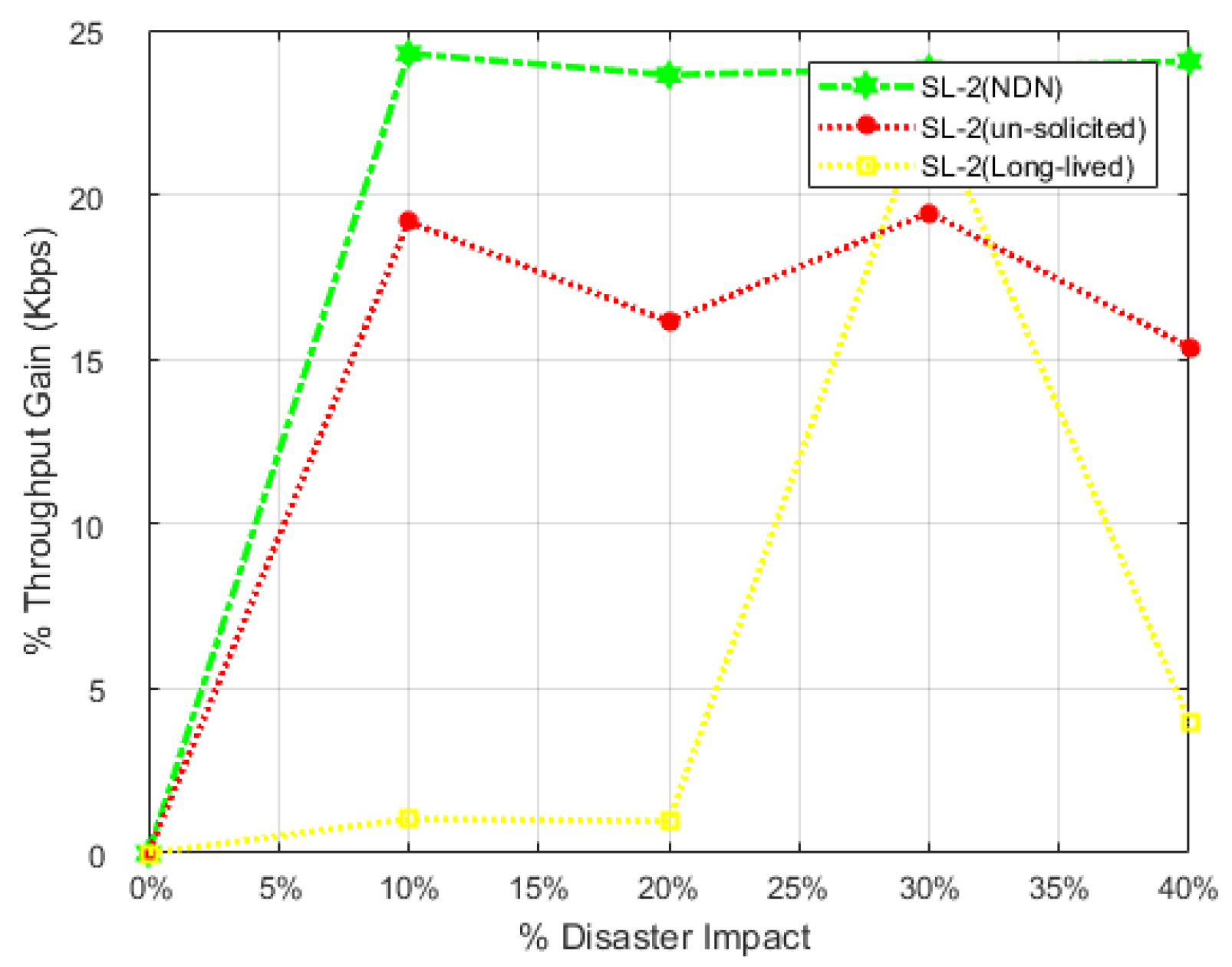
| Term | Abbreviation | Term | Abbreviation |
|---|---|---|---|
| BAM | Beacon Alert Message | CS | Content Store |
| CSR | Camper Server | DM | Data Message |
| DMS | Disaster Management System | FE-1 | Fire Exist 1 |
| FE-2 | Fire Exist 2 | FIB | Forwarding Information Base |
| FS | Fire Sensor | HC | Hop Count |
| IM | Interest Message | ICN | Information-Centric Networking |
| NDN | Named Data Networking | PIT | Pending Interest Table |
| RTO | Request Time Out | SC | Smart Campus |
| SCL | Smart Class | SL-1 | Smart Lab 1 |
| SL-2 | Smart Lab 2 | SFR | Smart Faculty Room |
| SLN | Smart Lawn | TL | Threshold Limit |
| VIF | Vanilla Interest Forwarding | vRTO | Virtual Request Time Out |
| Ref. | App. Scenario | DMS Support | Pull Support | Push Support | For IoT | Remarks |
|---|---|---|---|---|---|---|
| [26] | NDN-based Vehicular Network | ✗ | ✓ | ✓ | ✗ | Only valid for VNDN Not for IoT scenario |
| [28] | ICN communication for Disaster Scenarios | ✓ | ✓ | ✗ | ✗ | IoT and NDN Arch. not supported |
| [33] | CCN-based Disruptive Scenarios | ✗ | ✓ | ✗ | ✗ | Cached content in Disruptive CCN Arch. IoT Arch. not supported |
| [34] | NDN-based Emergency Message Delivery | ✗ | ✓ | ✗ | ✗ | IoT Arch. not supported |
| [23] | NDN-IoT based PUSH scehmes | ✗ | ✗ | ✓ | ✓ | DMS not supported |
| Proposed scheme | NDN-based DMS for SC | ✓ | ✓ | ✓ | ✓ | Suitable for IoT Arch. with DMS support |
| Parameter | Value/Name |
|---|---|
| ICN (Communication Stack) | NDN |
| Propagation Loss Model | Nakagami Propagation LossModel |
| Propagation Delay Model | Constant Speed Propagation Delay Model |
| Technology | WIFI_STANDARD_IEEE 802.11a ZIG_BEE_STANDARD_IEEE 802.15.4 |
| Mobility Model | Random_Disc_Position_Allocator Model for static nodes Random_Direction 2D Mobility Model for mobile nodes |
| Mobility speed | 0.2 s |
| CS Size | 1024 total locations |
| Each CS entry Size | 512 bytes |
| Seq. Range | 0–15 |
| Nodes/lab(room | Max 100, 67(static), 33 (mobile) |
| Number of nodes (Rooms+Labs+Lawn) | 4 × 20 = 80 Lawn = 20 |
| Messages frequency/s | 8–10/s |
| Area (m×m) | 50 × 100 |
| Caching Policy | LCE |
| Replacement Policy | LRU |
| Simulation Time (s) | 200 s |
| Ref. | Scheme Name | Scope | DMS Support | Theme Working | Remarks |
|---|---|---|---|---|---|
| [23] | Un-Solicited Data | Local area | ✗ | It is based on the RTO factor. The packets discard whenever the RTO timer expires. However, the acknowledge packet (i.e., aData) is not received and the discarded packets are re-transmitted from the producer which results in additional payload. | 1: In-feasible routing; 2: Only implementable in LAN; 3: Suitable for single hop network. |
| [23] | Long-Lived-Interest | Local and wide area | ✗ | It is based on the value of parameter, on which the vRTO parameter calculated which enables the stream of data packets through producer upto vRTO timer expires. The packets are discarded after vRTO expire and above mentioned procedure continues. | 1: Locked PIT entries up-to vRTO, which creates congestion; 2: Results, increase in delay due to additional payload; 3: Not suitable for NDN-IoT-DMS environment. |
| Proposed scheme | NDN-DISCA | Local and wide area | ✓ | It is based on the synthetic interest based BAM on fixed seq. no. “0” without any additional payload in the form of RTO, vRTO and . | 1: Suitable for IoT Arch; 2: Limited memory utilization due to fixed seq. no. selection; 3: The greater response time due to lack of additional payload factor. |
© 2018 by the authors. Licensee MDPI, Basel, Switzerland. This article is an open access article distributed under the terms and conditions of the Creative Commons Attribution (CC BY) license (http://creativecommons.org/licenses/by/4.0/).
Share and Cite
Hannan, A.; Arshad, S.; Azam, M.A.; Loo, J.; Ahmed, S.H.; Majeed, M.F.; Shah, S.C. Disaster Management System Aided by Named Data Network of Things: Architecture, Design, and Analysis. Sensors 2018, 18, 2431. https://doi.org/10.3390/s18082431
Hannan A, Arshad S, Azam MA, Loo J, Ahmed SH, Majeed MF, Shah SC. Disaster Management System Aided by Named Data Network of Things: Architecture, Design, and Analysis. Sensors. 2018; 18(8):2431. https://doi.org/10.3390/s18082431
Chicago/Turabian StyleHannan, Abdul, Sobia Arshad, Muhammad Awais Azam, Jonathan Loo, Syed Hassan Ahmed, Muhammad Faran Majeed, and Sayed Chhattan Shah. 2018. "Disaster Management System Aided by Named Data Network of Things: Architecture, Design, and Analysis" Sensors 18, no. 8: 2431. https://doi.org/10.3390/s18082431
APA StyleHannan, A., Arshad, S., Azam, M. A., Loo, J., Ahmed, S. H., Majeed, M. F., & Shah, S. C. (2018). Disaster Management System Aided by Named Data Network of Things: Architecture, Design, and Analysis. Sensors, 18(8), 2431. https://doi.org/10.3390/s18082431







